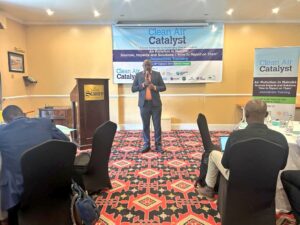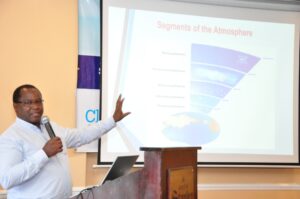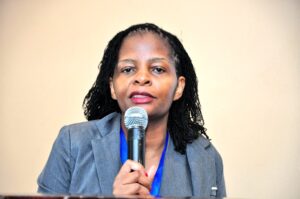The media has been urged to take center stage in disseminating positive information on clean air.
At this time, Nairobi is facing the challenges of pollution.

Maurice Kavai, the Deputy Director Air quality and climate change in Nairobi city county government speaking to journalists during the Clean Air Catalyst Media workshop in Nairobi, 28th, Feb 2023.
Addressing the media workshop on air pollution in Nairobi, Maurice Kavai, who is the Deputy Director of Air Quality and Climate Change in the Nairobi City County Government, observed that the media should think about unpacking knowledge to bring solutions to the challenges of air pollution.
“Let’s think of a solution to reduce the issue of air pollution in the city, The county is ready to take recommendations and suggestions to change the menace and bring about a clean environment, Mr. Kavai said when he addressed a media workshop in Nairobi.
He assured the participants that the county government is ready to share information with the media and end the bureaucracy that has characterized the issue, urging journalists to develop a positive perception that will improve the lives of Nairobi residents.
Air quality is a devolved function
More than 3 million people in Nairobi stand to benefit from clean resolutions as the Action Plan 2020–2050 has already been rolled out targeting clean air.
Studies have shown that the air quality is consistently poor in Nairobi, with average annual PM2.5 levels (fine particulate matter) more than double the World Health Organization’s (WHO) guidelines (WRI, 2021).
Statistical reports from the city county indicate that over 3,000 people live and work in the Dandora dumpsite, where 3,000 tonnes of waste materials are channeled to the area daily.
Mr. Sammy Simiyu, the Vital Strategist and Co-chair of the Health Committee, noted that air pollution has resulted in many deaths and has a great impact, especially for pregnant women.
“Air pollution affects adults and children as opposed to other diseases that might target specific groups of people such as coronavirus that mainly affects the elderly,” he said.
Studies have shown that 46 percent of deaths in Nairobi are the result of challenges related to air pollution.
“If a pregnant woman is exposed to air pollution, the unborn baby’s development will be affected, and you are likely to see the impact after the baby is born,” said Mr. Simiyu.
Media houses have faced constraints in reporting on the subject of air quality, mainly because of budgetary constraints, time constraints, and personnel dedicated to producing the stories.
There is also intimidation or fear of researching the air pollution stores because some of the hot spots, like Dandora, are heavily protected by locals since they are a source of livelihood for the residents.

Dr. Paul Njogu, Research and Data committee chair during presentations the Clean Air Catalyst Media workshop in Nairobi, 28th, Feb 2023.
Dr. Paul Njogu, Research and Data Committee chair, urged journalists to be conversant in reporting and emerging issues.
“Please be all round in reporting these shortcomings from climate change, human interest focuses on political scenes to reach a large mass but consider accuracy and put more interest and committed to learn more.’’ Dr. Paul Njogu.
Purity Munyambu, Gender Specialist at the World Resources Institute Africa (WRI), emphasized to the media to be careful and sensitive when reporting gender-sensitive stories.
“Let’s think through gender stereotyping when reporting sensitive stories to cause no harm and create an accommodative environment for both victims and the media,” Purity Munyambu urged.

Dr. Jackie Lidubwii, Internews Coordinator for the clean air Catalyst Pilot project in Nairobi during the Clean Air Catalyst Media workshop in Nairobi, 28th, Feb 2023.
Dr. Jackie Lidubwii, Internews Coordinator for the Clean Air Catalyst Pilot Project in Nairobi, expressed positive emotions about the exercise, saying it’s a milestone for the media to break the silence in reporting the air pollution menace.
“I’m excited to equip journalists with the tools to raise awareness & drive change on air pollution at this noble media workshop in full support of the Earth Journalism program. Despite being a disability champion, I will not get tired of speaking and sharing with the media, which is critical in informing the public, shaping perceptions, and driving policy relating to air pollution,” Dr. Lidubwii emphasized.








